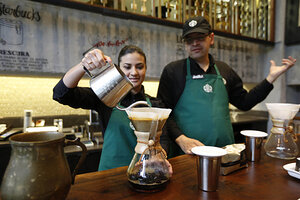Starbucks (SBUX) opens first store in Colombia. Watch out, Juan Valdez.
Starbucks (SBUX) opened its first store Wednesday in Colombia. Starbucks will be competing against Juan Valdez, a local Colombian coffee shop, which modeled itself off the Seattle chain.

A Starbucks employee demonstrates the preparation of a cup of coffee during a media tour of the new shop in Bogota, Colombia, Wednesday, July 16, 2014. The three-floor coffee house in Bogota is the first of 50 that the Seattle-based company plans to open here in the next five years.
Fernando Vergara/AP
Bogota, Colombia
Make room Juan Valdez, it's time to meet the green-aproned barista.
On Wednesday, Starbucks is making its much-anticipated debut in the country synonymous with coffee after years of roasting Colombia's Arabica beans for billions of java lovers the world over.
The three-floor coffee house in Bogota is the first of 50 that the Seattle-based company plans to open here in the next five years. In a nod to the country's proud coffee-growing tradition, it's also the only one in the world to serve exclusively locally-sourced coffee.
But will Colombians answer Starbucks' siren call and ditch a popular local chain bearing the bushy-whiskered coffee farmer's name?
Colombia's coffee federation, owner of the Juan Valdez chain, is outwardly welcoming the competition. The arrival of Starbucks it says will boost the market for gourmet java even if sales at its nearly 200 stores in Colombia take a hit over the short term
"There's room in the market for us both," said Alejandra Londono, head of international sales for the Colombian chain.
Juan Valdez's social mission promoting Colombian coffee and contributing to producers' welfare is likely to keep customers loyal, said Londono.
Since its founding 11 years ago, the Colombian chain has funneled more than $20 million to a national fund that supports the country's 560,000 coffee-growing families, some of whom also own shares in the company.
While Starbucks also has burnished its image for corporate responsibility, offering employees in the U.S. generous health care benefits and now online college courses, it's stayed clear of Colombia, Latin America's third largest economy, even as it has opened more than 700 stories in 12 other countries in the region. That may have been because it feared trampling on local sensibilities already hurt by the branding of coffee that leaves growers earning just a few pennies from every $4 venti latte sold.
Indeed, a desire to overcome the commodities curse is what's been driving the federation's focus on adding value up the retail chain, a strategy reflected in more sophisticated local coffee-drinking culture.
In 2010, Columbia, the world's fourth largest coffee producer, exported 534 million pounds of coffee, worth $2.3 billion, according to a report by the University of Pennsylvania's Wharton School of Business. Coffee growing accounts for 16 percent of the national agriculture growth domestic product.
While known for exporting the world's finest beans, until recently Colombians' taste in coffee was quite provincial, relegated to a preference for heavily-sweetened, warmed-over black coffee known as tinto, which is sold nearly everywhere.
Across from where Starbucks is opening on a leafy park in north Bogota, office workers at a rival Juan Valdez seemed thrilled with the prospect of having a new option for their late-afternoon caffeine fix. Service at their local coffee house, they said, has been improving ever since Starbucks announced it was coming a year ago.
"I like Juan Valdez but it doesn't mean I'll never go to Starbucks just because I want to support our own," said Marcela Gomez, an architect. "A little healthy competition is good."
Starbucks has been in the news recently for another reason. On Saturday, a woman in Pembroke Pines, Fla. bought the most expensive drink ever at Starbucks. The order: a Frappuccino with 60 shots of espresso, caramel syrup, white mocha, hazelnut, and soy milk, according to Consumerist. The total price for the drink– $60.58. For those thinking about trying to outdo this megafrap, it might be hard. Technically the drink violates Starbucks policy, which is not to serve drinks more than 31 oz. But this was a special case. The Florida woman called the store ahead of time to get permission to buy the drink.
In a letter to Consumerist, Starbucks wrote, "We want to ensure our customers receive the highest quality and most delicious tasting food or beverage products from us, and we don’t believe that this particular beverage choice was reflective of that."

